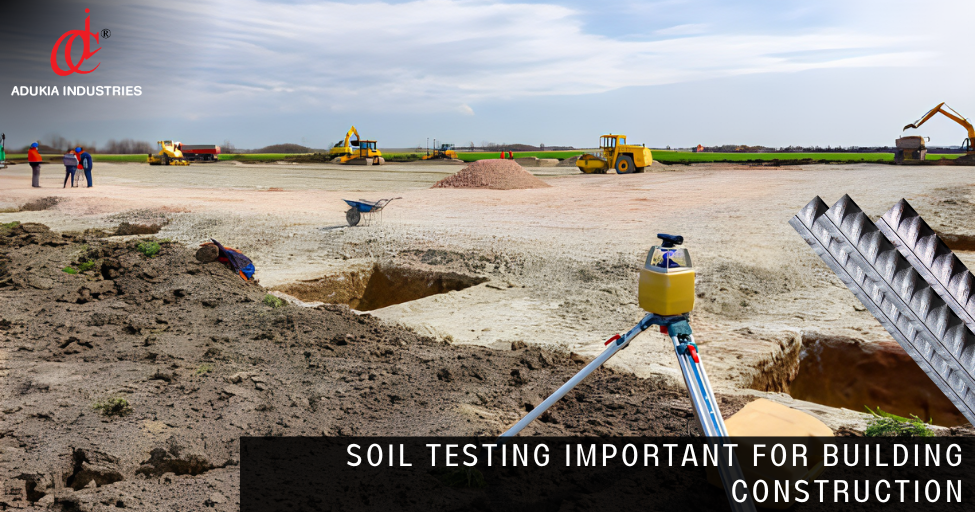
Why is soil testing important for building construction?
Do you want your construction project to turn out to be like the Leaning Tower of Pisa? Guess, nobody wants it either. To save your building from worse fatal dangers, you will have to go through soil testing, after purchasing the piece of land and before starting your construction project on it. In this blog, Adukia Industries the best TMT bar for house construction will help you understand what is soil testing, the types of soil testing and why testing is important before house construction. Without further ado, let’s get right into it.
What is soil testing?
In simple words. Soil testing is a scientific method with a scientific tool that helps in analysing and assessing the inherent physical properties as well as engineering properties of the soil along with its bearing capacity.
Soil Testing for constructing buildings helps in understanding the types of foundations to be laid. Our potential clients are suggested to go through soil testing before construction so that they understand how stable the construction project would turn out to be.
Different types of soil testing for construction
As the best TMT bar for house construction, In this section, we will be talking about the types of Soil Testing that are undertaken before starting construction of a building.
1. Gravity test
The Gravity of the soil is expressed as the ratio of the unit weight of the soil solids to the unit weight of water. The choice of method varies on factors like the nature of the material that is being tested. Here are the methods that fall under the specific gravity test.
2. Gas jar method
This method involves dipping a sample of soil in a gas jar filled with water to measure the volume of water that gets displaced. This method is commonly used for coarse-grained soils.
3. Measuring flask method
In this method, a sample of material is placed in a measuring flask to know its weight. The flask then is filled with water and then the weight is taken again. The two different weights allow the experts to calculate certain gravity while making it suitable for materials with irregular shapes.
4. Density bottle method
This method is specially used to design the density bottle with a certain volume. The substance is placed into the bottle with water, and it is weighed. The weight of the empty bottle with only the material is also measured. The reason for applying this method is for fine-grained materials such as powders and soils.
5. Moisture content test
There are several ways through which measuring soil moisture can be done like radiation method, alcohol method, sand bath method, the Pycnometer method, torsion method, oven drying method and the calcium carbide method. However, the popular moisture content testing is the oven-drying method, Calcium Carbide method, Torsion method and Pycnometer Method.
Here are the key methods used to test soil moisture for construction
6. Gravimetric method (oven-drying method)
This method is the most accurate in testing soil and is widely used as well. It includes collecting soil samples, weighing them and then wetting them. After wetting the soil they are dried at a specific temperature at 110 degrees Celsius and then weighed again to calculate the moisture content that depends on the weight difference.
7. Calcium carbide method
This method is about collecting soil samples and mixing them with calcium carbide, which reacts with water and produces acetylene gas. When the gas is produced it becomes proportional to the moisture content in the soil.
8. Torsion balance method
This method looks out for the weight loss of a soil sample during the process of drying. It goes with both field and laboratory applications.
9. Pycnometer method
This method is about using a calibrated glass container (Pycnometer) for measuring soil moisture content. The sample at first is saturated with water, resulting in changing the volume which is then used for calculating moisture content. It is often used in laboratory settings for its high precision.
10. Atterberg limits test
This type of soil testing is used in measuring the crucial water content of fine-grained soil.
11. Shrinkage limit
It is a mathematical formula that determines the water content, filling the soil’s voids.
Ws = (M2 – M1)n – (V1 – V2) Pw / M2
M1 = initial mass
V1= initial volume
M2= dry mass
V2= volume after drying
Pw = density of water
12. Plastic limit
In this, the soil content is mixed with water so that it can form plastic. The soil is then shaped into a ball structure and rolled into 3mm threads. The motto is to break the thread, if it doesn’t then the same process is repeated with a new soil sample and less water. This process keeps on going until the thread is broken.
13. Liquid limit
A casa grande’s liquid limit is used, made up of a cup with a device that rises and falls to measure the soil’s liquid limit.
14. Dry density test
As the Best TMT Bar for House Construction, we would like to bring insight into the dry density test in which the soil is calculated by the weight of particles of the soil in a particular sample. The dry density varies on the void ratio and the soil’s specific gravity, which then is used to classify the soil into several densities loose, medium or dense. The test goes through three methods water replacement, core cutter and sand replacement.
15. Water replacement
In this method, a preferred volume of soil is contained in a preferred volume container to see the increase in the water levels. Then the dry density is determined by using the weight of the soil and the shift in water level, keeping in mind the specific gravity of water.
16. Core cutter
This method is all about driving a cylindrical core cutter into the soil at a preferred depth and drawing out a soil core. The volume and the weight of the drawn-out core are measured and allow the calculation of dry density.
17. Sand replacement
This process is about creating a hole in the ground, where the soil is removed and replaced by a known weight of sand. The sand that replaced the soil is for calculating the soil’s volume and by getting the weight of the soil the dry density can be easily determined.
18. Proctor’s compaction test
The Proctor’s Compaction test is a method used in the laboratory for controlling the optimum mixture content at which the soil type will be most dense and achieve its maximum dry density.
19. Permeability test
This test shows how well water can permeate the soil. The property of permeability takes part in an indispensable and critical role that focuses on the stability and hydraulic structures, including bridges as well as retaining walls. The permeability also plays an important role in controlling the stability of slopes. It is measured in terms of the permeability coefficient (k). The two most common laboratory techniques used for controlling soil permeability are the Falling Head Test and the Constant Head Test.
20. Consolidation test
This method involves a gradual reduction in soil volume due to the decreasing presence of pore water. Soils generally consist of soil particles and pore water. The excess pore water takes place when the load is applied to the soil. As a result, a moderate transfer of pressure arises from the pore water to the soil stratum. For this pressure transfer the soil tends to contract in volume.
Note that there are three types of Consolidation processes such as
- Initial consolidation
- Primary consolidation
- Secondary consolidation
How soil testing is important for construction?
As mentioned before at the beginning of this blog by Adukia Insutries the best TMT bar for house construction, testing of soils is indeed important before starting your construction project over it. Here are the points that will highlight the importance of soil testing.
- Soil testing controls the depth and length of the pillars that are inserted into the ground to lay the building’s foundation.
- Soil testing controls the likelihood of foundation issues and the best methods for construction to use.
- The water table level is determined by soil testing.
- The chemical and mineral composition of the soil can impact the chosen material for construction.
- Sometimes the soil testing gives results of soil containing sulphur, and therefore sulphur-resistant cement is used to protect the structure’s foundation.
- Soil testing is extremely important when the construction is about building multi-storey apartments, as it will determine the gripping properties of the soil when the pillars are inserted into the ground.
- Soil testing with the help of various methods can show the reactivity of the soil to certain weather conditions on-site.
Conclusion
Soil testing is a crucial step in construction, making sure of the longevity and stability of structures or buildings. Adukia Industries emphasizes the importance of pairing this with the best TMT bar for house construction. Extensive soil analysis highlights decisions of foundations, addresses moisture concerns and makes sure of the optimal selection of building materials along with preventing potential hazards.
Comments(4)
Leave a comment
Category
Recent Post
West Bengal’s Expanding Horizons: Exploring The Current TMT Bar Price In West Bengal
Mon July 2024
Top 10 TMT Bar Brands In India
Tue July 2024
Why Is Corrosion A Major Threat To Infrastructure? A Detailed Analysis of Corrosion Resistant TMT Bars
Fri July 2024
Where to get good quality TMT bars at the best price in Bihar?
Sat July 2024

